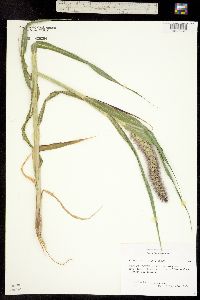Setaria italica
|
|
|
|
Family: Poaceae
foxtail bristlegrass, more...Italian Bristle Grass, foxtail millet, Italian foxtail, Millet des Oiseaux, Sétaire d'Italie, Sétaire Italienne
[Chaetochloa germanica (Mill.) Smyth, moreChaetochloa italica (L.) Scribn., Chaetochloa italica var. germanica (Mill.) Farw., Chamaeraphis italica (L.) Kuntze, Chamaeraphis italica var. germanica (Mill.) Kuntze, Echinochloa intermedia Roem. & Schult., Ixophorus italicus (L.) Nash, Panicum germanicum Mill., Panicum italicum L., Panicum italicum var. californicum (Kellog) Körn. & Werner, Panicum italicum var. germanicum (Mill.) Döll, Panicum italicum var. inerme Döll, Panicum italicum var. italicum L., Panicum viride subsp. italicum (L.) Asch. & Graebn., Panicum viride var. italicum (L.) Backer, Pennisetum germanicum (Mill.) Baumg., Pennisetum italicum (L.) R. Br., Setaria californica Kellog, Setaria germanica (Mill.) P. Beauv., Setaria italica subsp. germanica (Mill.) Douin, Setaria italica var. germanica (Mill.) Beck, Setaria italica var. metzgeri (Koern.) Jáv., Setaria italica var. stramineofructa (F.T. Hubbard) Bailey, Setaria viridis subsp. italica (L.) Briq., Setariopsis italica (L.) Samp.] |
Plants annual. Culms 10-100 cm. Sheaths mostly glabrous, margins sparsely ciliate; ligules 1-2 mm; blades to 20 cm long, 1-3 cm wide, flat, scabrous. Panicles 8-30 cm, dense, spikelike, occasionally lobed below; rachises hispid to villous; bristles 1-3, to 12 mm, tawny or purple. Spikelets about 3 mm, disarticulating between the lower and upper florets. Lower glumes 3-veined; upper glumes 5-7-veined; lower paleas absent or 1/2 as long as the lower lemmas; upper lemmas very finely and transversely rugose to smooth and shiny, exposed at maturity. 2n = 18. Setaria italica was cultivated in China as early as 2700 B.C. and during the Stone Age in Europe. Nowdays it is grown mostly for hay or as a pasture grass, but it has been used as a substitute for rice in northern China. It is sometimes cultivated in North America, but it is better known as a weed in moist ditches, mostly in the northeastern United States. It is closely related to S. viridis, differing in the longer (3 mm) spikelets and smooth, shiny upper florets which readily disarticulate above the lower florets. It exhibits considerable variation in seed and bristle color, bristle length, and panicle shape. Using these characters, Hubbard (1915) recognized several infraspecific taxa; they are not treated here. Annual herb, tufted 10 cm - 1 m tall Leaves: alternate, two-ranked. Sheaths sparsely fringed with hairs. Ligules 1 - 2 mm wide, membranous, marginally fringed with hairs. Blades to 20 cm long, 1 - 3 cm wide, lance-shaped, flat, rough, parallel-veined. Inflorescence: a terminal arrangement of spikelets (panicle), dense, 8 - 30 cm long, spike-like, with numerous bristles about 12 mm long. Axis hairy. Bristles purple or tawny. Fruit: a caryopsis, indehiscent, enclosed within the persistent lemma and palea, ellipsoid to nearly spherical. Culm: upright or decumbent, 10 cm - 1 m long, round in cross-section. Spikelets: nearly stalkless to short-stalked, about 3 mm long, lance-shaped to ellipsoid. Glumes:: Lower glumes less than half as long as spikelets, three-veined, membranous. Upper glumes half as long or nearly equal to upper lemmas, five- to seven-veined. Lemmas:: Lower lemmas equal to upper lemmas, five- to seven-veined, membranous. Upper lemmas hardened, smooth and shiny or finely wrinkled, exposed at maturity. Paleas:: Lower paleas absent or half as long as lower lemmas. Upper paleas hardened, wrinkled. Florets:: Lower florets sterile or male. Upper florets bisexual. Anthers three. Styles two. Stigmas red. Similar species: No information at this time. Flowering: July to mid-August Habitat and ecology: A rare weed in the Chicago Region, often found in cultivated ground and fallow areas. Its origin is uncertain. Occurence in the Chicago region: non-native Etymology: Setaria comes from the Latin words seta, meaning bristle, and aria, meaning possessing. Italica means Italian. Author: The Morton Arboretum Vegetatively like the larger forms of no. 5 [Setaria viridis (L.) P. Beauv.], with lobulate infls, but with larger spikelets ca 3 mm, the fertile lemma smooth and shiny, disarticulating above the more persistent glumes and sterile lemma; sterile palea half as long as its lemma, which is usually shorter than the fertile lemma; 2n=18. Old-World cultigen, thought to be derived from no. 5, cult. for fodder or grain, and occasionally found as a weed nearly throughout our range. Gleason, Henry A. & Cronquist, Arthur J. 1991. Manual of vascular plants of northeastern United States and adjacent Canada. lxxv + 910 pp. ©The New York Botanical Garden. All rights reserved. Used by permission. From Flora of Indiana (1940) by Charles C. Deam This species has been sparingly sown as a forage crop and has escaped. For detailed information on the value of the species as a forage crop and its culture, see H. N. Vinall on Foxtail Millet (U. S. Dept. Agric. Farmers' Bull. 793). …… Indiana Coefficient of Conservatism: C = null, non-native Wetland Indicator Status: FACU Deam (1929): Foxtail millet has not been extensively sown in Indiana except that formerly, when the season was late, farmers resorted to it as a forage crop. Since a wider use is now made of peas and beans as a forage crop, the use of millet is on the decline. |















































































